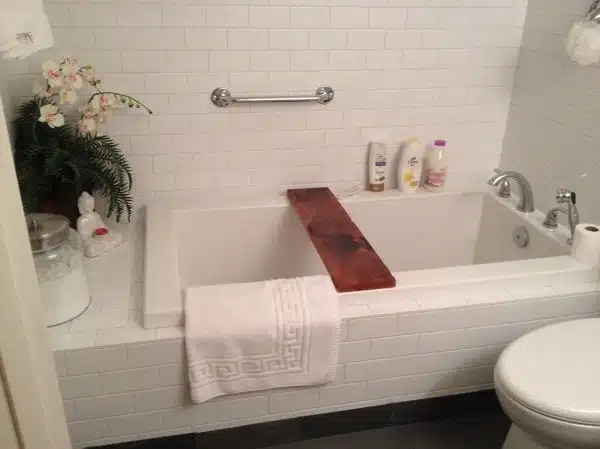As a bathroom design and remodeling expert, I understand the challenges of creating a functional and stylish space, especially when working with limited square footage. When it comes to tiny bathrooms, one of the best ways to maximize space while still incorporating luxury is by investing in a soaker tub. Soaker tubs provide the perfect opportunity to relax and unwind after a long day, but purchasing one for a small bathroom requires careful planning and consideration.
In this article, I will share my insights on how to buy a soaker tub for a tiny bathroom. From measuring your space to selecting the right style and materials, I will cover everything you need to know in order to make an informed decision. Whether you’re looking for a deep soaking experience or simply want to add some elegance to your bathroom, this guide will help you choose the perfect soaker tub for your small space without sacrificing functionality or comfort.
Assessing Your Bathroom Space
When it comes to designing a tiny bathroom, maximizing space is key. Creative storage options are essential to avoid clutter and maintain a visually appealing environment. Assessing the available space is crucial before deciding on the type of soaker tub that would be suitable for the bathroom.
To make the most of the limited space, consider installing a wall-mounted vanity with cabinets underneath to store toiletries and towels. Floating shelves or corner shelves can be added to provide additional storage without taking up too much floor space. A built-in niche in the shower area can also serve as a convenient spot for shampoo and soap.
Another way to maximize space is by selecting a compact soaker tub that fits perfectly in your bathroom. Consider freestanding or corner soaker tubs, which take up less floor space than traditional built-in tubs. Understanding the various styles of soaker tubs will help you choose the one that best suits your needs and preferences.
Understanding Soaker Tub Styles
Soaker tubs come in a variety of styles, which can influence the look and feel of your tiny bathroom. One major style choice is whether to go with a freestanding or alcove model. Freestanding soaker tubs are not attached to any walls and tend to have more space around them for a luxurious spa-like feel. Alcove soaker tubs, on the other hand, are built into a three-wall enclosure and offer a more traditional look that is great for maximizing floor space.
Another consideration when selecting a soaker tub style is whether you want something modern or traditional. Modern soaker tubs often feature clean lines, minimalist design, and sleek materials like acrylic or stone resin. Traditional models may have more ornate detailing and be crafted from materials like cast iron or copper.
Ultimately, the style of your soaker tub will depend on your personal preferences and the overall aesthetic of your bathroom. Consider factors like available space, desired ambiance, and budget when making your decision. In the next section, we’ll explore how to choose the right material for your soaker tub to ensure it meets both your design goals and practical needs.
Choosing The Right Material
As you consider purchasing a soaker tub for your tiny bathroom, it is important to choose the right material that will fit your needs and preferences. The material of the tub can affect its durability, maintenance requirements, and overall appearance. To help you make an informed decision, let’s compare some popular materials used for soaker tubs: acrylic vs. cast iron, fiberglass vs. composite.
Acrylic vs. Cast Iron:
- Acrylic is a lightweight material that can be molded into various shapes and sizes. It is also easy to clean and maintain.
- Cast iron is a heavy-duty material that can retain heat well, providing a longer soaking time. It also has a classic look that fits traditional bathroom designs.
Fiberglass vs. Composite:
- Fiberglass is another lightweight option that is affordable and easy to install. However, it may not be as durable as other materials.
- Composite materials are made of resin or polymer mixed with other substances such as stone or metal particles. They offer durability, strength, and customizable designs.
Each material has its unique pros and cons when it comes to soaker tubs. Consider what factors are important for your lifestyle and preferences before making a final decision.
Determining your budget is the next step in choosing the right soaker tub for your tiny bathroom. By having a clear understanding of how much you are willing to spend on both the purchase and installation of the tub, you can narrow down your options further and find the perfect match for your needs.
Determining Your Budget
Before purchasing a soaker tub for your tiny bathroom, it is important to establish a budget. Creating a wishlist of features that you want in your tub will help determine the price range you are comfortable with. Take into consideration the size, material, and style of the tub that would best suit your needs.
Researching prices from various retailers and manufacturers will give you an idea of the average cost of a soaker tub. Keep in mind that prices can vary depending on the quality of materials used and additional features such as jets or heating elements. It is also important to factor in any installation costs that may arise.
Once you have established a budget, stick to it to avoid overspending. A soaker tub can be a luxurious addition to your bathroom, but it should not break the bank. With careful planning and research, finding the perfect soaker tub for your tiny bathroom can be affordable and stress-free.
Transition: Now that you have established a budget for your soaker tub, it is time to consider the installation requirements for this addition to your bathroom.
Considering Installation Requirements
Installing a soaker tub in a tiny bathroom can be a challenge, but it is not impossible. With the right planning and consideration, you can enjoy the luxury of soaking in your own bathtub even in limited space. There are installation challenges that you need to keep in mind before purchasing your dream soaker tub.
One of the primary installation challenges is plumbing considerations. A soaker tub requires more water than a regular bathtub, which means that it needs a larger drain and water supply lines. If your bathroom’s existing plumbing cannot accommodate these requirements, you may need to upgrade or modify the plumbing system to ensure sufficient water supply and drainage. This can add to the overall cost of installing your soaker tub.
Another installation challenge is the weight of the tub. Soaker tubs tend to be heavier than regular bathtubs due to their size and material, which means that additional support may be needed for installation. The floor must be strong enough to carry the weight of both the tub and water when filled. In some cases, wall reinforcement may also be necessary to secure the tub properly.
To make sure that you have everything covered before installing your soaker tub, here are some plumbing considerations that should not be overlooked:
- Check if your water heater has enough capacity to fill up a larger bathtub.
- Ensure proper ventilation as increased humidity from frequent use can lead to mold growth.
- Consider accessibility for future maintenance or repairs.
With these challenges in mind, it’s essential to consult with an expert contractor before purchasing and installing a soaker tub in your tiny bathroom. They will help assess any potential issues and provide recommendations on how best to proceed with installation while keeping safety standards intact.
Moving forward into measuring for the perfect fit, taking accurate measurements is crucial for ensuring that your new soaker tub fits perfectly within your tiny bathroom without causing any obstruction or inconvenience.
Measuring For The Perfect Fit
Accurate measurement is crucial when it comes to buying a soaker tub for a tiny bathroom. Before making any purchase, it is important to measure the available space in your bathroom. This will help you determine whether or not the tub you have your eye on will fit perfectly into your bathroom. Measuring accuracy can make or break your remodeling project.
When measuring for a soaker tub, ensure that you take precise measurements of the length and width of the available space in your bathroom. Additionally, take note of any features such as windows, doors and fixtures like sinks and toilets that may limit the amount of space available for installation. This will help you determine if there are any alternative options that may work better for your specific situation.
Inaccurate measurements can result in purchasing a bathtub that is too large or too small for your bathroom. If this happens, finding alternative options may become more difficult and costly. Therefore, it’s essential to be diligent when taking measurements to avoid any unnecessary expenses and time-consuming setbacks during the remodeling process. Once you have accurate measurements, exploring space-saving features can be the next step towards creating a functional yet stylish tiny bathroom.
Exploring Space-Saving Features
Having measured your bathroom for the perfect soaker tub, it’s now time to explore space-saving features that will transform your tiny bathroom into a relaxing oasis. Compact designs are ideal for small spaces and can provide all the luxury of a full-sized tub. Equally important is the need for creative solutions that make the most of every inch of your small bathroom.
One option for maximizing space in a small bathroom is to consider a corner soaker tub. These tubs are designed to fit snugly into a corner, providing ample room for other fixtures like toilets and sinks. Another space-saving design feature is an oval-shaped soaker tub that fits against a wall or under a window. This type of tub not only saves space but also provides an elegant focal point in your bathroom.
In addition to compact designs, evaluating drain and overflow options is another crucial step towards finding the perfect soaker tub for your tiny bathroom. Many modern soaker tubs come with built-in overflow protection, which means that they can be filled up higher without water spilling over onto the floor. Additionally, choosing a drain with the right placement can make all the difference when it comes to saving space in your small bathroom. With these considerations in mind, you’ll be well on your way to selecting the perfect soaker tub that checks all the boxes for style, functionality, and comfort.
Evaluating Drain And Overflow Options
When purchasing a soaker tub for a tiny bathroom, evaluating the drain and overflow options is crucial. The placement of the overflow is an essential consideration as it determines how high you can fill the tub with water. An overflow located near the top edge of the tub allows for maximum water depth, while one situated closer to the bottom edge may limit how much water you can add. Therefore, before making a purchase, ensure that you know where your overflow will be positioned.
Another critical factor to consider when selecting a soaker tub for your small bathroom is the drain size. Generally, there are two options available: standard and toe-tap. Standard drains are what most people are familiar with; they have a knob that you turn to open or close them. Toe-tap drains, on the other hand, require you to push down on them with your foot to open or close them. Although they occupy less space than standard drains, toe-tap drains may not be ideal if you have mobility issues.
It’s essential to keep in mind that various factors will influence which drain and overflow option works best for your tiny bathroom. Among these factors include personal preference and budgetary constraints. However, by taking into account aspects such as overflow placement and drain size options, you’ll be able to make an informed decision about which tub best suits your needs.
Moving forward in our discussion about buying a soaker tub for a tiny bathroom, we’ll now look at selecting a comfortable size that fits within your available space without compromising functionality or comfortability.
Selecting A Comfortable Size
- When selecting a soaker tub for a small bathroom, it is important to consider the measurements of the space to ensure the tub fits properly.
- A soaker tub should be placed in a location of the bathroom that allows for ample space for the user to move around, as well as allowing for easy access in and out of the tub.
- In addition to the measurements of the space, it is also important to consider the capacity of the tub, as a larger capacity tub may not fit in a small bathroom.
- A smaller capacity tub can easily accommodate one person, while a larger capacity tub can accommodate two or more people.
- If the space allows, the installation of a corner soaker tub can save additional space in the bathroom, and provide additional room for other bathroom amenities.
- Finally, before purchasing a soaker tub, it is important to measure the space carefully and ensure that the desired tub will fit properly and comfortably within the bathroom.
Measurement Considerations
When it comes to buying a soaker tub for a tiny bathroom, measurement considerations play a crucial role in selecting a comfortable size. Maximizing space is essential, especially in small bathrooms where every inch counts. As a bathroom design and remodeling expert, I recommend taking accurate measurements of the available space before purchasing any bathtub.
Creative solutions can also be used to make the most out of small spaces. For example, if the bathroom has an awkward corner or alcove, consider installing a triangular or oval-shaped soaker tub that fits snugly into the available space. Additionally, freestanding tubs are excellent choices for maximizing space as they take up less floor area compared to built-in models.
When selecting the appropriate size of a soaker tub for a tiny bathroom, it’s vital to keep in mind that comfort should not be compromised for space-saving purposes. A too-small bathtub can be uncomfortable and impractical. On the other hand, an oversized tub can overwhelm the limited space and make it challenging to navigate around the bathroom. Therefore, it’s crucial to strike a balance between comfort and practicality when choosing a soaker tub for a tiny bathroom.
Space Requirements
When designing a bathroom, selecting the right size for a soaker tub is important to maximize functionality and comfort. However, it’s not just about fitting the tub into the available space; one also needs to consider the necessary clearance around the bathtub. The minimum requirement for an alcove or built-in tub is 30 inches by 60 inches, while that of a freestanding model is at least 32 inches by 60 inches. Ensuring enough clearance allows for ease of movement and access to other bathroom fixtures.
Maximizing functionality in a small bathroom can be challenging, but creative storage solutions can help free up valuable floor space. For instance, installing wall-mounted shelves or cabinets can keep toiletries organized and off the countertop, opening up more space for moving around. Another creative solution is using built-in niches or recessed shelves within shower walls to provide additional storage without sacrificing room.
When selecting a soaker tub size for a small bathroom, finding the right balance between function and form is crucial. It’s essential to choose a size that fits well within the available space yet provides adequate comfort. A too-small bathtub might feel cramped and uncomfortable, while an oversize one could overwhelm and make the bathroom look cluttered. As such, taking accurate measurements of both available space and necessary clearance will ensure choosing an appropriate-sized soaker tub that meets both practicality and comfort requirements.
Capacity Options
When selecting a soaker tub, homeowners often focus on the size and style of the bathtub. However, water depth and weight capacity are also crucial factors to consider. Water depth is essential for ensuring a comfortable soaking experience, while weight capacity ensures that the tub can hold individuals of various sizes safely.
For water depth, it’s essential to choose a tub size that allows for adequate water coverage without overflowing. The standard water depth for most soaker tubs ranges from 14 to 16 inches deep. However, some models may offer deeper depths for those who desire a more immersive soaking experience. It’s important to note that deep water can be heavy, which is why weight capacity is also essential when selecting a soaker tub.
Weight capacity refers to the amount of weight the bathtub can hold without causing damage or instability. Most standard-sized bathtubs have a weight capacity of around 300 pounds. However, larger models may have higher weight capacities to accommodate heavier individuals or couples who want to soak together comfortably. When selecting a soaker tub size, it’s important to consider both water depth and weight capacity to ensure maximum comfort and safety during use.
Comparing Jetted And Non-Jetted Soaker Tubs
Ironically, one of the most significant factors to consider when buying a soaker tub for a tiny bathroom is its size. While it may seem counterintuitive to choose a larger tub for a smaller space, selecting the right dimensions will ensure maximum comfort and relaxation during your bath time. Therefore, it is crucial to measure your bathroom’s available floor area before making any purchase decisions.
Once you have determined the appropriate size for your tiny bathroom soaker tub, it is time to consider whether you want jetted or non-jetted options. Both types come with their unique benefits and drawbacks, which we will explore in detail in the next section. For now, let us focus on some common hydrotherapy benefits associated with soaking in a warm bath. Hydrotherapy can help alleviate muscle pain, reduce stress levels, and improve sleep quality.
While soaking in a luxurious soaker tub can be an incredibly rejuvenating experience, it is essential to keep cleaning considerations in mind. Cleaning and maintaining a soaker tub can be time-consuming and challenging if not done correctly. Some materials are easier to clean than others, like acrylic or fiberglass, while natural stone requires more care and attention. Understanding maintenance requirements before making your purchase decision will save you from unnecessary stress down the line.
| Jetted Tubs | Non-Jetted Tubs |
|---|---|
| Provide Massage Therapy | More Affordable |
| Require Regular Cleaning | Easier Maintenance |
| Can Increase Water Usage | Quieter Soaking Experience |
| Offer Customizable Settings | Fewer Mechanical Parts |
Understanding maintenance requirements is crucial when considering purchasing either type of soaker tub for your tiny bathroom. In the next section, we will discuss how jetted and non-jetted soaker tubs differ regarding their maintenance needs. Additionally, we will delve deeper into each type’s unique benefits and drawbacks to help you make an informed decision that suits your needs best.
Understanding Maintenance Requirements
Maintaining a soaker tub in a tiny bathroom can be quite challenging. It is essential to consider the pros and cons of owning a soaker tub before purchasing one. The main advantage of a soaker tub is that it provides a relaxing and luxurious spa-like experience. On the other hand, they require regular cleaning and maintenance to prevent mold, mildew, and bacteria buildup.
Cleaning your soaker tub regularly is crucial to ensure its longevity. Use mild detergents or cleaners that are safe for acrylic or fiberglass surfaces. Avoid using abrasive cleaners or scrubbers as they may damage the finish of your tub. If you have hard water, consider investing in a water softener system to reduce mineral buildup on your tub’s surface.
When it comes to maintaining your soaker tub, prevention is key. After each use, rinse the interior with warm water and wipe it down with a soft cloth to remove any soap residues or debris. Also, make sure that there is proper ventilation in your bathroom to prevent excess moisture buildup, which can lead to mold growth. Keeping these cleaning tips in mind will help keep your soaker tub looking new for years to come.
Transition into the subsequent section about ‘deciding on aesthetic features’:
Now that you understand the maintenance requirements of owning a soaker tub let’s move onto deciding on aesthetic features that would suit your tiny bathroom best.
Deciding On Aesthetic Features
To truly make your soaker tub the centerpiece of your tiny bathroom, it’s important to consider the aesthetic features that will complement the overall design and feel of the space. Start by thinking about color options: do you want a tub that blends seamlessly into the background, or one that stands out as a bold statement piece? Neutral colors like white or beige are classic choices that can create a sense of calm and relaxation, while bolder hues like blue or green can add a pop of personality to an otherwise understated room.
Another way to customize your soaker tub is with decorative accents. Consider adding details like metal feet or intricate tile work around the edges of the tub to give it a little extra flair. Small touches like this can go a long way in elevating the look and feel of your bathroom. Just be sure not to go overboard – too many decorative elements can quickly become overwhelming in a small space.
When selecting aesthetic features for your soaker tub, it’s important to keep in mind how they will fit with both your personal style and the existing design elements in your bathroom. The goal is to create a cohesive look that feels intentional and thoughtfully executed. By focusing on color options and decorative accents, you can transform even the smallest bathroom into a luxurious oasis.
To ensure you’re getting exactly what you want when it comes to aesthetics, take some time to read reviews and compare brands before making your final decision. This will help you understand what other customers have experienced with different products and which brands are most reliable when it comes to quality and customer service. With these factors in mind, you’ll be well on your way to finding the perfect soaker tub for your tiny bathroom – one that looks just as good as it feels.
Reading Reviews And Comparing Brands
1.When looking for a soaker tub for a small bathroom, it is important to read reviews and compare brands in order to make an informed decision. 2.Researching product reviews and customer feedback can provide insight into the quality and durability of particular brands. 3.Comparing brands can help to identify which products are the most suitable for a particular space, as well as which features are most important to consider. 4.Careful consideration of these factors can ensure that a soaker tub is chosen which is both aesthetically pleasing and practical for the space.
Reading Reviews
When it comes to buying a soaker tub for a tiny bathroom, reading reviews is an essential step in the process. Imagine yourself sitting in a luxurious tub, enjoying the warm water and relaxing after a long day. However, without proper research and analysis, this dream can quickly turn into a nightmare. As a bathroom design and remodeling expert, I highly recommend taking the time to read reviews before making any purchase.
Analyzing credibility is crucial when reading reviews. You want to ensure that the source of the review is reliable and trustworthy. Look for reviews from reputable websites or individuals who have experience with the product. Be wary of fake reviews or those that seem too good to be true. Identifying biases is also essential when reading reviews as some may have personal connections to the brand or may receive compensation for their positive opinions.
Reading reviews can provide valuable insight into different brands and models of soaker tubs available on the market. By analyzing credibility and identifying biases, you can make an informed decision on which tub best suits your needs and fits your tiny bathroom space. Remember to take your time when researching and reading reviews to ensure that you make the best possible choice for yourself and your home renovation project.
Comparing Brands
When it comes to selecting a soaker tub for your tiny bathroom, comparing brands is an essential step in the process. Each brand has its own unique features, price range, customer reviews, and material quality that can make a significant difference in your decision-making process. As a bathroom design and remodeling expert, I suggest taking the time to carefully evaluate each brand’s pros and cons before making any purchase.
One critical factor to consider when comparing brands is their price range. Soaker tubs come in various price ranges, from budget-friendly options to luxury models that can cost thousands of dollars. It’s crucial to determine how much you’re willing to spend before beginning your search for the perfect soaker tub. Similarly, reading customer reviews can help you gain insight into how well each brand’s products perform at different price points.
Another important aspect to compare among brands is the material quality and warranty options they offer. Soaker tubs are typically made of materials such as acrylic or cast iron, which can affect their durability and longevity. Additionally, some brands may offer better warranty options than others, providing peace of mind knowing that you’re covered if something goes wrong with your purchase down the line.
In conclusion, comparing brands is a crucial step when selecting a soaker tub for your tiny bathroom. By evaluating factors such as price range, customer reviews, material quality, and warranty options among different brands available on the market today; you can make an informed decision about which one best suits your needs and fits within your budget constraints. Remember always to take your time when researching and comparing brands before making any purchase decision.
Consulting With A Professional
Consulting with a professional when choosing a soaker tub for your tiny bathroom can help you avoid costly mistakes and ensure that the installation meets building codes. However, there are both benefits and drawbacks to working with a professional.
One of the main benefits of consulting with a professional is access to their expertise. A bathroom design and remodeling expert can help you choose the right type of soaker tub for your space, taking into consideration factors such as size, style, and placement. They can also advise you on additional features to enhance the functionality of your tub, such as jets or a built-in heater.
On the other hand, one of the drawbacks of consulting with a professional is cost. You will need to pay for their time and expertise, which can add up quickly depending on how much work needs to be done. Additionally, finding the right professional for your needs can be challenging. It’s important to do your research and ask potential candidates questions about their experience and credentials before hiring them.
When looking for a professional to consult with about your soaker tub installation, start by asking friends or family members who have recently completed similar projects for recommendations. You can also search online directories or review sites to find local professionals in your area. Once you have a list of potential candidates, set up appointments to meet with each one and ask questions about their experience working on similar projects, their pricing structure, and any guarantees they offer on their work.
Transition: Now that you’ve considered the benefits and drawbacks of consulting with a professional and have found some potential candidates, it’s time to move on to making your final decision about which soaker tub is right for your tiny bathroom.
Making Your Final Decision
As the consultation with a professional comes to an end, it’s time to make that final decision on buying a soaker tub for your tiny bathroom. Remember, as an old adage goes, “measure twice, cut once.” This means that before you make any purchase, you should take all the necessary measurements twice to avoid making any mistakes.
When looking at different options for soaker tubs, it’s important to weigh the pros and cons of each style. A freestanding tub may be aesthetically pleasing but may take up more space than a built-in model. On the other hand, a built-in model may be more practical but could lack in visual appeal. Consider what is most important to you and your bathroom design goals.
Common mistakes when purchasing a soaker tub include not taking accurate measurements or not considering installation requirements such as plumbing and electrical needs. Additionally, some people overlook the importance of choosing a quality brand and model that will last for years to come. Take the time to research different brands and models before making your final decision.
Remember that purchasing a soaker tub for your tiny bathroom is an investment in both comfort and style. By following these guidelines and taking into account the pros and cons of each option, as well as avoiding common mistakes, you can ensure that your new soaker tub will be both functional and visually appealing in your small bathroom space.
Conclusion
When it comes to buying a soaker tub for a tiny bathroom, there are several factors you need to consider. Firstly, assess your bathroom space and understand the different styles of soaker tubs available. Once you have determined the style, choose a material that is suitable for your needs and budget.
Consider the installation requirements and aesthetic features before making your final decision. Reading reviews and comparing brands can also help you make an informed decision. Consulting with a professional can provide valuable insights and ensure that the installation process goes smoothly.
In conclusion, buying a soaker tub for a tiny bathroom requires careful consideration of various factors. Just like designing a bathroom, it involves balancing aesthetics with functionality in limited space. As an expert in bathroom design and remodeling, I recommend visualizing your dream bathroom as a puzzle where every piece must fit perfectly to create a harmonious whole. A soaker tub can be the centerpiece of this puzzle, providing both relaxation and beauty to your small but elegant sanctuary.
Image Credits
- “home – Soaker bath tub” by EatLiveGrowPaleo.com (featured)





























